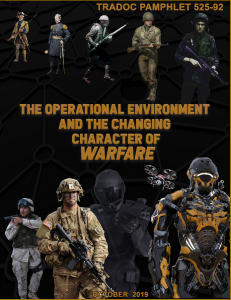 [Editor’s Note: The U.S Army Training and Doctrine Command and Army Futures Command recently updated and published The Operational Environment and the Changing Character of Warfare, and the accompanying Potential Game Changers handout to reflect what we are learning about the Operational Environment (OE). Addenda included insights gleaned from our recent Mad Scientist conferences and guest blog post submissions, as well as direct input received from you all — our Mad Scientist Community of Action — thank you! Today’s blog post provides a synopsis of these latest updates — Enjoy!]
[Editor’s Note: The U.S Army Training and Doctrine Command and Army Futures Command recently updated and published The Operational Environment and the Changing Character of Warfare, and the accompanying Potential Game Changers handout to reflect what we are learning about the Operational Environment (OE). Addenda included insights gleaned from our recent Mad Scientist conferences and guest blog post submissions, as well as direct input received from you all — our Mad Scientist Community of Action — thank you! Today’s blog post provides a synopsis of these latest updates — Enjoy!]
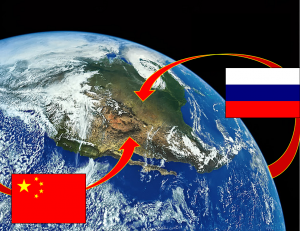 At some point during The Era of Accelerated Human Progress (now through 2035), and really for the first time since the Second World War, it is likely that the United States could face a true strategic competitor who will have the ability to operate in multi-domains, the capability to deny domains to U.S. forces, and who will be able to operate with certain technological advantages over U.S. forces. This challenge is further compounded by our reliance on coalition warfare with allies who might not be able or willing to modernize at the same pace as the U.S.
At some point during The Era of Accelerated Human Progress (now through 2035), and really for the first time since the Second World War, it is likely that the United States could face a true strategic competitor who will have the ability to operate in multi-domains, the capability to deny domains to U.S. forces, and who will be able to operate with certain technological advantages over U.S. forces. This challenge is further compounded by our reliance on coalition warfare with allies who might not be able or willing to modernize at the same pace as the U.S.
As the world becomes further digitized, states will share their strategic environments with networked societies which could pose a threat by circumventing governments that are unresponsive to their citizens’ needs. These online organizations are capable of gaining power, influence, and capital to a degree that challenges traditional nation-states. Many states will face challenges from insurgents and global identity networks – ethnic, religious, regional, social, or economic – whose members may feel a stronger affinity to their online network than to their nationality, which could result in them either resisting state authority or ignoring it altogether.
 The revolution in connected devices and virtual power projection will increase the potential for adversaries to target our installations. Hyper-connectivity increases the attack surface for cyber-attacks and the access to publicly available information on our Soldiers and their families, making personalized warfare and the use of psychological attacks and deepfakes likely. A force deploying to a combat zone will remain vulnerable from the Strategic Support Area – including individual Soldiers’ personal residences, home station installations, and ports of embarkation – all the way forward to the Close Area fight during its entire deployment.
The revolution in connected devices and virtual power projection will increase the potential for adversaries to target our installations. Hyper-connectivity increases the attack surface for cyber-attacks and the access to publicly available information on our Soldiers and their families, making personalized warfare and the use of psychological attacks and deepfakes likely. A force deploying to a combat zone will remain vulnerable from the Strategic Support Area – including individual Soldiers’ personal residences, home station installations, and ports of embarkation – all the way forward to the Close Area fight during its entire deployment.
 The balkanization of the internet into multiple national “intranets” could provide fewer opportunities for influence platforms and impact cyber operations. The growing presence of fake news, data, and information, coupled with deepfakes and hyper-connectivity, changes the nature of information operations. The convergence of deepfakes, AI-generated bodies and faces, and AI writing technologies – that appear authentic – are corrosive to trust between governments and their populations, and present the potential for devastating impact on nation-states’ will to compete and fight.
The balkanization of the internet into multiple national “intranets” could provide fewer opportunities for influence platforms and impact cyber operations. The growing presence of fake news, data, and information, coupled with deepfakes and hyper-connectivity, changes the nature of information operations. The convergence of deepfakes, AI-generated bodies and faces, and AI writing technologies – that appear authentic – are corrosive to trust between governments and their populations, and present the potential for devastating impact on nation-states’ will to compete and fight.
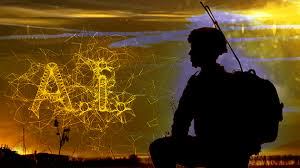 Artificial Intelligence (AI) may be the most disruptive technology of our time: much of today’s “thought” is artificial, vice human. However, certain operational environments are data-scarce. Missing inputs caused by data gaps inhibit a narrow AI’s ability to provide the envisioned benefits in assessing the OE, limiting military application. Decision cycle times will decrease with AI-enabled intelligence systems conducting collection, collation, and analysis of battlefield information at machine speed, freeing up warfighters and commanders to do what they excel at – fight and make decisions. AI will become critical in processing and sustaining a clear common operating picture in this data-rich environment.
Artificial Intelligence (AI) may be the most disruptive technology of our time: much of today’s “thought” is artificial, vice human. However, certain operational environments are data-scarce. Missing inputs caused by data gaps inhibit a narrow AI’s ability to provide the envisioned benefits in assessing the OE, limiting military application. Decision cycle times will decrease with AI-enabled intelligence systems conducting collection, collation, and analysis of battlefield information at machine speed, freeing up warfighters and commanders to do what they excel at – fight and make decisions. AI will become critical in processing and sustaining a clear common operating picture in this data-rich environment.
 Passive sensing, especially when combined with artificial intelligence and big-data techniques may routinely outperform active sensors, leading to a counter-reconnaissance fight between autonomous sensors and countermeasures – “a robot-on-robot affair.” These capabilities will be augmented by increasingly sophisticated civilian capabilities, where commercial
Passive sensing, especially when combined with artificial intelligence and big-data techniques may routinely outperform active sensors, leading to a counter-reconnaissance fight between autonomous sensors and countermeasures – “a robot-on-robot affair.” These capabilities will be augmented by increasingly sophisticated civilian capabilities, where commercial 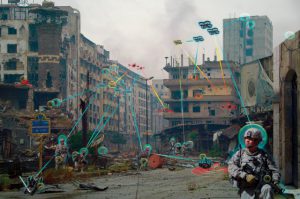 imagery services, a robust and mature Internet of Things, and near unlimited processing power generate a battlespace that is more transparent than ever before. This transparency may result in the demise of strategic and operational deception and surprise.
imagery services, a robust and mature Internet of Things, and near unlimited processing power generate a battlespace that is more transparent than ever before. This transparency may result in the demise of strategic and operational deception and surprise.
 The proliferation of intelligent munitions will enable strikers to engage targets at greater distances, collaborate in teams to seek out and destroy designated targets, and defeat armored and other hardened targets, as well as defiladed and entrenched targets.
The proliferation of intelligent munitions will enable strikers to engage targets at greater distances, collaborate in teams to seek out and destroy designated targets, and defeat armored and other hardened targets, as well as defiladed and entrenched targets.
Unmanned systems, including advanced battlefield robotic systems acting both autonomously and as part of a wider trend in man-machine teaming, will account for a significant percentage of a combatant force.  Swarms of small, cheap, scalable, and disposable unmanned systems will be used both offensively and defensively, creating targeting dilemmas for sophisticated, expensive defensive systems. Swarming systems on the future battlefield will include not only unmanned aerial systems (UAS) but also swarms across multiple domains with self-organizing, self-reconstituting, autonomous, ground, maritime (sub and surface), and subterranean unmanned systems. Advanced robotic vehicles could serve as mobile power generation plants and charging stations, while highly dexterous ground robots with legs and limbs could negotiate complex terrain allowing humans access to places otherwise denied. This raises the question: Is using a human Soldier in a dangerous situation ethical when there are robots available?
Swarms of small, cheap, scalable, and disposable unmanned systems will be used both offensively and defensively, creating targeting dilemmas for sophisticated, expensive defensive systems. Swarming systems on the future battlefield will include not only unmanned aerial systems (UAS) but also swarms across multiple domains with self-organizing, self-reconstituting, autonomous, ground, maritime (sub and surface), and subterranean unmanned systems. Advanced robotic vehicles could serve as mobile power generation plants and charging stations, while highly dexterous ground robots with legs and limbs could negotiate complex terrain allowing humans access to places otherwise denied. This raises the question: Is using a human Soldier in a dangerous situation ethical when there are robots available?
 Biotechnology will see major advances, with many chemical and materials industries being replaced or augmented by a “bio-based economy” in which precision genetic engineering allows for bulk chemical production. Individualized genetics enable precise performance enhancements for cognition, health, longevity, and fitness. The low cost and low expertise entry points into genomic editing, bioweapon production, and human enhancements will enable explorations by state, non-state, criminal, and terrorist organizations. Competitors may not adopt the same legal regulations or ethics for enhancement as the U.S., causing asymmetry between the U.S. and those choosing to operate below our defined legal and ethical thresholds.
Biotechnology will see major advances, with many chemical and materials industries being replaced or augmented by a “bio-based economy” in which precision genetic engineering allows for bulk chemical production. Individualized genetics enable precise performance enhancements for cognition, health, longevity, and fitness. The low cost and low expertise entry points into genomic editing, bioweapon production, and human enhancements will enable explorations by state, non-state, criminal, and terrorist organizations. Competitors may not adopt the same legal regulations or ethics for enhancement as the U.S., causing asymmetry between the U.S. and those choosing to operate below our defined legal and ethical thresholds.
 Space is becoming an increasingly congested, commercialized, democratized, and contested domain. A maneuver Brigade Combat Team has over 2,500 pieces of equipment dependent on space-based assets for PNT and Low Earth Orbit is cluttered with satellites, debris, and thousands of pieces of refuse.
Space is becoming an increasingly congested, commercialized, democratized, and contested domain. A maneuver Brigade Combat Team has over 2,500 pieces of equipment dependent on space-based assets for PNT and Low Earth Orbit is cluttered with satellites, debris, and thousands of pieces of refuse.
Shifting demographics, such as youth bulges in Africa and aging populations of traditional allies and competitors, will threaten economic and political stability. These factors will be attenuated by a changing climate, which likely will become a direct security threat. Risks to U.S. security include  extreme weather impacting installations, increased resource scarcity and food insecurity, climate migration increasing the number of refugees and internally displaced peoples, and the Arctic as a new sphere of competition.
extreme weather impacting installations, increased resource scarcity and food insecurity, climate migration increasing the number of refugees and internally displaced peoples, and the Arctic as a new sphere of competition.
Our understanding of technological innovations through 2035 has broadened in several areas:
-
- Robotics: The advent of legged locomotion and robotic dexterity, with robots becoming less vehicle-like, able to replicate animal or a human characteristics.
 Quantum Computing: The expansion of Quantum applications across to the full spectrum of sciences will affect Precision, Navigation, and Timing (PNT), especially relevant in GPS-denied environments, as well as improved sensors and imaging.
Quantum Computing: The expansion of Quantum applications across to the full spectrum of sciences will affect Precision, Navigation, and Timing (PNT), especially relevant in GPS-denied environments, as well as improved sensors and imaging.- Space: Presence in this domain will expand to over 70 nations.
- Missiles: The addition of maneuverability to hypersonic capabilities presents further challenges in the development of effective countermeasure systems.
We also refined our descriptions of several disruptive technologies anticipated through 2050:
-
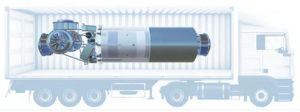 Power: Proliferation of electric/battery powered vehicles, laser charging, small modular advanced nuclear power delivering electricity via directed energy (DE) and electric transportation, and the harnessing of Thermionic power — harvesting energy at the nano-level — which is scalable to megawatts.
Power: Proliferation of electric/battery powered vehicles, laser charging, small modular advanced nuclear power delivering electricity via directed energy (DE) and electric transportation, and the harnessing of Thermionic power — harvesting energy at the nano-level — which is scalable to megawatts.- Medical Advances: The ability to produce artificial cells on demand and the advent of tailored vaccines.
- Insensitive Munitions: The development of multifunctional munitions, tailorable to specific mission sets and functions.
 Information Environment: Instantaneous recall, sensor-saturated environment, unmanned asset intelligence collection, algorithmic processing of high volumes of information, and virtual and augmented reality.
Information Environment: Instantaneous recall, sensor-saturated environment, unmanned asset intelligence collection, algorithmic processing of high volumes of information, and virtual and augmented reality.
We welcome your input on these or any additional aspects of the OE and the changing character of warfare — What are we missing?
If you enjoyed this post, please also see:
-
- Ground Warfare in 2050: How It Might Look, by Dr. Alexander Kott
-
- Making the Future More Personal: The Oft-Forgotten Human Driver in Future’s Analysis, by Mr. Ian Sullivan



